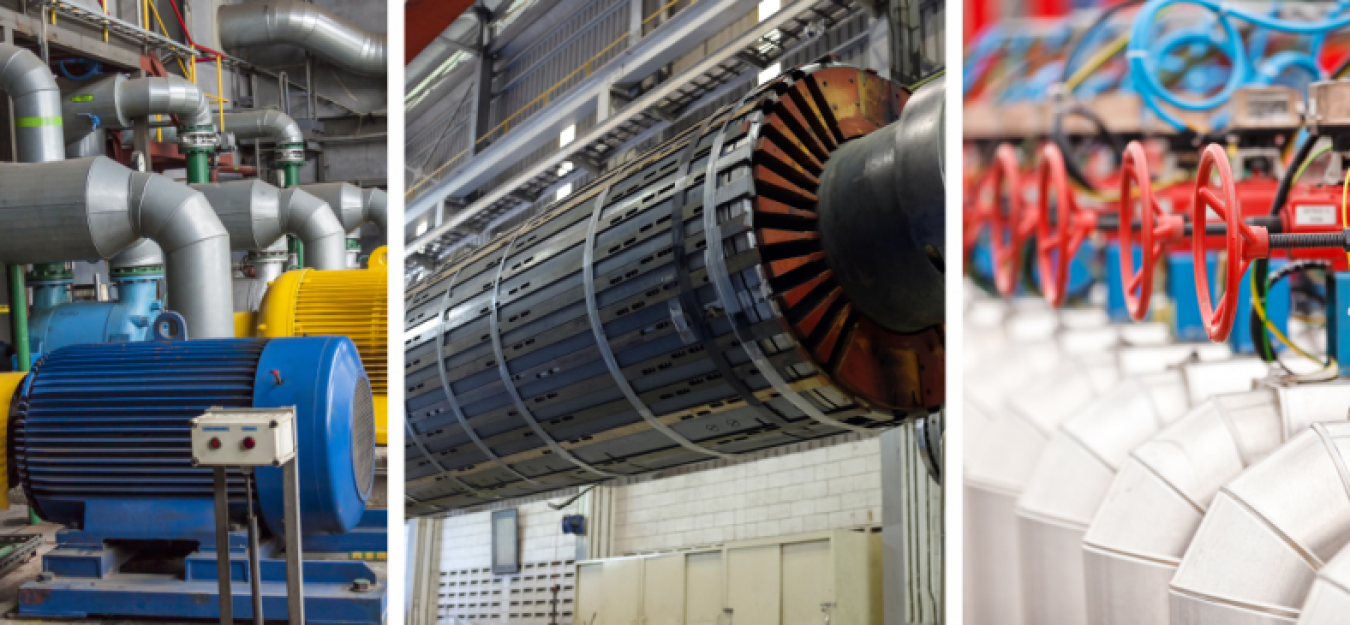
In 2013, electricity accounted for approximately 40% of primary energy consumption in the United States and manufacturing was responsible for more than a quarter of end‐use. Electric motor‐driven systems used 68% of this total electricity for essential energy intensive industrial processes such as refrigeration, pumps, fans, compressors, materials handling, materials processing, and facility HVAC systems.
AMO’s Next Generation Electric Machines (NGEM) program is an RD&D effort leveraging recent technology advancements in power electronics and electric motors to develop a new generation of energy efficient, high power density, high speed, integrated medium voltage (MV) drive systems for a wide variety of critical energy applications.
Improvements to industrial electric motor systems can be realized through the application of key enabling technologies, such as wide bandgap devices, advanced magnetic materials, improved insulation materials, aggressive cooling techniques, high speed bearing designs, and improved conductors or superconducting materials. The NGEM program will facilitate a step-change that enables more efficient use of electricity, as well as reduced drive system size and weight, developing lasting capabilities for motor material development and design that will reduce industry’s energy footprint and greenhouse gas emissions while supporting U.S. global competitiveness in clean energy products.
This RD&D effort consists of two separate funding opportunities so far and will leverage the work of the Department’s Power America Institute on WBG semiconductors. The funding opportunities and selected projects are listed below.
NGEM: MEGAWATT CLASS MOTORS
Five projects were selected in September 2015 with the goal of merging wide-bandgap (WBG) technology with advancements for large-scale motors. The projects will develop medium voltage integrated drive systems that leverage the benefits of wide bandgap devices with energy efficient, high speed, direct drive, megawatt class electric motors for efficiency and power density improvement in the chemical and petroleum refining industries, natural gas infrastructure, and general industry compressor applications like HVAC systems, refrigeration, and wastewater pumps. These application areas represent a significant number of motor installations, a large amount of electrical energy consumption, and significant opportunities for U.S. technology and manufacturing competitiveness. The aim of the projects is to reduce the size of megawatt-scale motors and drive systems by up to 50 percent and cut energy waste by as much as 30 percent.
SiC enabled High-Frequency Medium Voltage Drive for High-Speed Motors
Integrated Electric Drive with HV2 Modular Electric Machine and SiC Based Power Converters
Fully Integrated High Speed Megawatt Class Motor and High Frequency Variable Speed Drive System
Integrated 15kV SiC VSD and High-Speed MW Motor for Gas Compression Systems
NGEM: ENABLING TECHNOLOGIES
Thirteen projects were selected in November 2016 aimed at advancing technologies that will drive cost-effective efficiency enhancements and weight reductions in electric machines while addressing the limitations of traditionally used conductive metals and electrical steels. The goal of the initiative is to develop and demonstrate scalable, high throughput processes for manufacturing enabling technologies, including:
- high performance thermal and electrical conductor,
- low-loss silicon steel manufacturing,
- high temperature superconducting wire manufacturing, and
- other enabling technologies to increase performance.
These enabling technologies could help manufacturers cumulatively save nearly 44 terawatt-hours per year, roughly 1.6% of total U.S. electricity consumption, and pave the path for further savings in variable-speed motors. In addition, these same technologies will improve motors used in the growing clean energy sector, helping wind, solar, electric vehicle, and battery manufacturers.
Nanometal-Interconnected Carbon Conductors for Advanced Electric Machines
Metal (Cu, Al) CNT Composite Wires for Energy Efficient Motors
Carbon Conductors for Lightweight Motors and Generators
Si-Al-Cr-Mn Alloy for High Specific Resistivity
High-Silicon Steel Strip by Single-Step Shear Deformation Processing
Enhanced 2G HTS Wire for Electric Motor Applications
Processes for 2G HTS Wire Manufacturing
Cost-effective Conductor, Cable, and Coils for High Field Rotating Electric Machines
Amorphous and Nanocomposite Magnets for High Efficiency, High Speed Motor Designs
Resistively Graded Insulation System for Next-Generation Converter-Fed Motors

